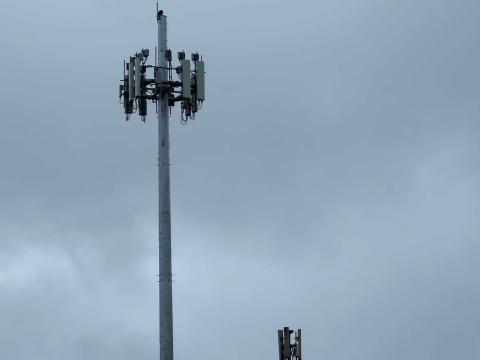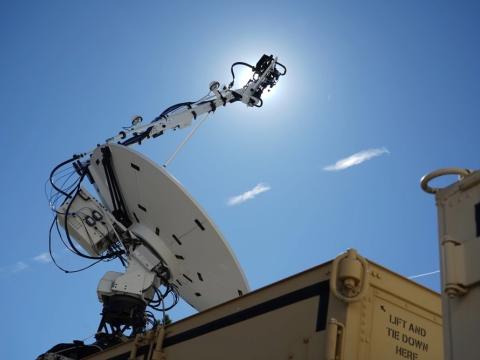Tactical Networking Program Takes Aim at Mobile Targets
Defense agency explores enhanced capabilities in radar sensing and tracking.
The U.S. Air Force is investigating the feasibility of a coordinated precision engagement system that will enable airborne units to more accurately target an adversary’s mobile ground and surface units. Using advanced sensor systems designed for next-generation fighter and surveillance aircraft, service officials hope to combine capabilities in existing air-to-ground missile systems to detect and track seagoing or land-based vehicles from long range, in any weather.
The U.S. military is working toward enhancing command and control in battlefield surveillance and reconnaissance activities. The development of ground moving target indication (GMTI) radar changed the complexion of engagement by enabling fighting units to track enemy movements. In doing so, the radar also spurred the development of detection avoidance techniques. Many of these evasive countermeasures involve tactics and equipment movement that confound target tracking and battle management.
In response to these challenges, the Defense Advanced Research Projects Agency (DARPA), working in conjunction with the Air Force Research Laboratory (AFRL) Information Directorate, is leading the three-phase Affordable Moving Surface Target Engagement (AMSTE) program. The program, for which experiments are scheduled through fiscal year 2003, brings to bear existing airborne sensor resources to enable U.S. forces to fix, track and engage nonstationary targets from a nonengagement, stand-off distance.
According to Stephen Welby, AMSTE program manager, DARPA Special Projects Office, Arlington, Virginia, the objective is to deny the “sanctuary of movement” now enjoyed by mobile weapons. Lessons learned from the Gulf War and from recent engagements in the Balkans have shown stationary targets to be vulnerable to a majority of offensive weapons fielded today. “It’s clear that our opponents will use mobility to escape future engagement by U.S. forces and that the idea of mobility will increase across doctrines and platforms,” Welby contends. “To counter this threat, we will need increasingly effective time-critical targeting to rapidly and precisely locate tactical targets in support of real-time fire control processes.”
Phase one of the AMSTE program examined the potential for airborne units to engage ground moving targets using multiple target indicating sensors to guide precision ground- and air-launched weapons. A study was conducted to review a variety of moving-target-engagement concepts. The two study participants, The Boeing Company, Seattle, and Raytheon Company, El Segundo, California, coupled multiple GMTI sensors through airborne networks to detect and track simulated moving targets and update in-flight weapons. Initial test results demonstrated that a greater degree of targeting and tracking accuracy could be achieved by tapping a combination of sensor and tracker capabilities.
Although generally precise in measuring the down range to a chosen mobile target, individual GMTI sensors have difficulty determining parallel cross-ranges between targeting platforms and targets. In some cases, area-effect munitions have been the only recourse for eliminating mobile targets. This often causes collateral damage to untargeted units. Welby explains that accurate detection and tracking can be achieved through position triangulation, in which data are combined from two platforms looking at the same moving target. AMSTE would integrate capabilities from multiple radar sensor systems and create new targeting and tracking methods, eliminating the need to build expensive replacement systems.
The proposed AMSTE technique addresses another issue. In most cases, U.S. forces can locate and track contacts in a wartime situation. However, the limits of existing radar sensors are tested when contacts require tracking for extended periods of time. The ability to update specific target locations from point to point is critical to the precision of various global positioning system (GPS)- and inertial navigation system (INS)-enabled weapons such as the joint stand-off and joint direct attack guided missiles. AMSTE accomplishes this by using multiple sensors working in tandem.
“To enable multiple GMTI systems to hold a tight track on a target, we need to fuse the sensors on a network so that data comparisons can be made to find common target coordinates,” Welby asserts. “The AMSTE solution will make any weapon of choice part of this scenario so that, as sensors collect updated information on a target, the data can be passed to a weapon en route to the objective.” Unlike single-sensor tracking, coordinating multiple sensors increases the probability of countering any evasive maneuvers by the target, he adds. The AMSTE notion is of a virtual, node-oriented environment, with each node representing a weapon or sensor. The integration of weapon systems intelligence with tactical targeting network technology will allow datalinking in a shared loop format, from sensor to operator to weapon system, enabling regular target status updates.
Also during the first phase of the AMSTE program, DARPA conducted precision fire control tracking analysis using simulated air-to-ground targets to test airborne detection. Funded by Alphatech Company, Boston, and Orincon Company, San Diego, target tracking was attempted using input from multiple sensors to provide real-time position coordinates. Tracking algorithms were developed from collected data and on the basis of a goal of sub-10-meter precision moving target location. Various target vehicles included tanks, tactical ballistic missile transporters and small boats. “Robustness in tracking systems is important to a command’s ability to ingest data from different sensory equipment and produce precise solutions instantaneously against potentially lethal moving targets,” Welby explains.
Leveraging the capabilities of multiple weapons and sensors to adapt existing technologies to new missions is a primary program objective. A major portion ofDARPA’s research has been on determining the most efficient reconfiguration for existing systems to save on the cost of building new ones. “This only works if you don’t sacrifice weapon effectiveness in the process,” Welby points out.
The Maverick antitank guided missile is an example of the need for cost savings in datalink-operated systems. The weapon features a video-camera-equipped sensor that enables it to be controlled from the launch aircraft; however, the onboard equipment is relatively expensive for a completely expendable system.
The AMSTE program focuses on low-cost GPS- and INS-based systems that can be used to continually update track coordinates. The AFRL is exploring the use of off-board, nonexpendable sensors to execute missions that were previously one-way for the equipment involved. According to Welby, costly missile-mounted sensor systems can be integrated into launch platforms by joining the characteristics of multiple command and control techniques into a single intelligent network. Aside from the savings that accompanies reusable systems, this method also reduces the number of people needed for mission control by incorporating greater autonomy within the central command network itself, he adds.
The second phase of AMSTE, begun in the fall of 2000, was the first step in bringing the coordinated capabilities of the project together in a functional system. Jon Jones, program manager for the AFRL’s Information and Intelligence Exploitation Division, Rome, New York, explains that phase two will demonstrate the system’s operational utility by physically integrating selected tracking and sensory equipment into a single communications network. Competing contracts totaling more than $23 million have been awarded to Northrop Grumman Corporation, Melbourne, Florida, and Raytheon, for the development of two implementation models of the proposed AMSTE system.
“Both companies will be looking at a variety of sensors including Teledyne Ryan Aeronautical’s Global Hawk unmanned surveillance system and Northrop Grumman’s joint surveillance tracking and attack radar system,” Jones indicates. “The program is looking to develop techniques that are not specific to a particular platform but are applicable across a wide range of manned and unmanned reconnaissance and advanced fighter aircraft.”
Signature-aided tracking is one of the capabilities that DARPA is currently investigating. Welby explains that this will involve experimenting with non-GMTI radar modes, such as imaging and high-range resolution profile modes, to help enhance capabilities in target characterization.
“By coupling methods in tracking and radar, we can produce multiple images of a target over time for comparison purposes to ensure that what was seen at time A is still the same target at time B,” Welby declares. “What will enable us to maintain target identification over time is a node-based network that filters data collected by various sensors, presenting an educated conclusion as to what is being monitored.” Raytheon and Northrop Grumman are conducting research on signature-aided tracking sensors that can be employed as part of an operational targeting system using tactical targeting network technology.
Testing of the prototype platforms produced by Raytheon and Northrop Grumman will commence this summer. The primary scenario will consist of a controlled number of contacts in an open environment. “Coordinating the tracking elements of a multiple signal-node network with the corresponding weapons elements will be a goal,” Welby comments. “Being able to maintain a track during the battle management process so that the proper weapons can be delivered precisely to their targets will be key to the system’s continued evolution.”
The final phase of the program will commence from fiscal year 2002 through fiscal year 2003 and present a successively more complex series of target scenarios to push tracking and sensor development. Aside from greater target numbers and variations, the use of higher vehicle speeds, man-made and natural terrain obstacles and differing light levels will provide increased challenges to test the AMSTE architecture’s robustness, Welby notes. As the system evolves, program researchers will confront more dynamic vehicle scenarios. When vehicles join with other mechanized formations, radar-dependent tracking can often lose a target in the shuffle of joint force movements. This is where signature-aided tracking within a highly precise framework of sensors will significantly improve precision, he adds.
The adoption of a Link 16 or Joint Tactical Information Distribution System (JTIDS) communications backbone will enable the AMSTE network, initially limited to air platform stationing, to connect with ground and surface commands. “Establishing seamless connectivity with any GPS or INS communications platform willallow the tracking of targets and launching of weapons systems from air-, land- or sea-based network-ready stations,” Welby emphasizes. “Ultimately, the communications demands of an increasingly dynamic battlefield may push an end-to-end AMSTE network beyond the boundaries of a JTIDS infrastructure in promoting the seamless, real-time linking of all network-bound elements within a given task force.”
Full integration of an operational AMSTE network into a field-ready command and control environment is slated for the summer of 2003. Although initiated primarily for Air Force-related targets and weapon systems development, the program, according to Welby, will expand to support surface-to-surface weapons fielded by both naval and land combat forces. The potential for future implementation of the system in international coalition operations will grow as the benefits of GMTI sensing continue to drive trends in weapon systems commonality, he remarks.




Comments